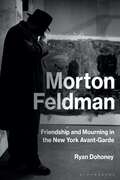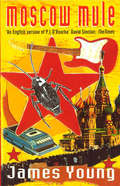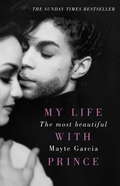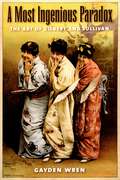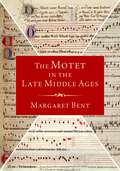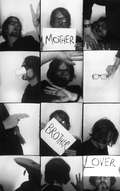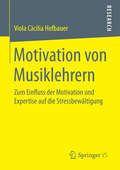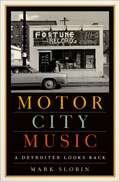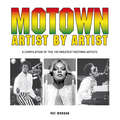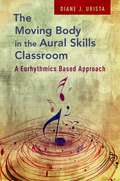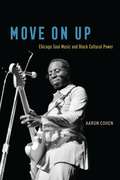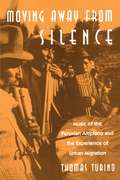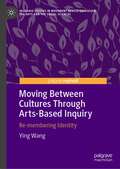- Table View
- List View
Morton Feldman: Friendship and Mourning in the New York Avant-Garde
by Ryan DohoneyMorton Feldman: Friendship and Mourning in the New York Avant-Garde documents the collaborations and conflicts essential to the history of the post-war avant-garde. It offers a study of composer Morton Feldman's associations and friendships with artists like John Cage, Jackson Pollock, Philip Guston, Frank O'Hara, Charlotte Moorman, and others. Arguing that friendship and mourning sustained the collective aesthetics of the New York School, Dohoney has written an emotional and intimate revision of New York modernism from the point of view of Feldman's agonistic community.
Moscow Mule
by James YoungA marvellously funny and sharply observed account of a journey to Russia by one of Britain's most talented young writers. Moscow - a labyrinth where the humans try to keep one step ahead of the roaches. Everyone on the move, some in search of the quick buck, and others just trying to survive. All dazzled by the neon glare of the western dream. The soviet monolith has broken down in tribalism, tribes who go to war not just on the streets but in overheated rooms, with drugs, vodka and Cindy Crawford carrier bags. James Young gives an unparalleled account of today's Moscow from the bottom side up. He takes us on a odyssey through this strange no man's land where East meets West, where the old certainties have gone, the KGB men wear Italian suits, the Mafia tycoonskis style themselves on the Godfather flicks and the rest are queuing to change dollars.
The Most Beautiful: My Life With Prince
by Mayte GarciaIn The Most Beautiful, a title inspired by the hit song Prince wrote about their legendary love story, Mayte Garcia for the first time shares the deeply personal story of their relationship and offers a singular perspective on the music icon and their world together: from their unconventional meeting backstage at a concert (and the long-distance romance that followed), to their fairy-tale wedding (and their groundbreaking artistic partnership), to the devastating losses that ultimately dissolved their romantic relationship for good. Throughout it all, they shared a bond more intimate than any other in Prince's life. No one else can tell this story or can provide a deeper, more nuanced portrait of Prince--both the famously private man and the pioneering, beloved artist--than Mayte, his partner during some of the most pivotal personal and professional years of his career. The Most Beautiful is a book that will be returned to for decades, as Prince's music lives on with generations to come.
A Most Ingenious Paradox: The Art of Gilbert and Sullivan
by Gayden WrenWritten more than a century ago and initially regarded even by their creators as nothing more than light entertainment, the fourteen operas of Gilbert & Sullivan emerged over the course of the twentieth century as the world's most popular body of musical-theater works, ranking second only to Shakespeare in the history of English-language theater. Despite this resounding popularity and proven longevity, most books written about the duo have focused on the authors rather than the works. With this detailed examination of all fourteen operas, Gayden Wren fills the void. His bold thesis finds the key to the operas' longevity, not in the clever lyrics, witty dialogue, or catchy music, but in the central themes underlying the characters and stories themselves. Like Shakespeare's comedies, Wren shows, the operas of Gilbert & Sullivan endure because of their timeless themes, which speak to audiences as powerfully now as they did the first time they were performed. Written out of an abiding love for the Savoy operas, this volume is essential reading for any devotee of these enchanting works, or indeed for anyone who loves musical theater.
A Most Ingenious Paradox: The Art of Gilbert and Sullivan
by Gayden WrenWritten more than a century ago and initially regarded even by their creators as nothing more than light entertainment, the fourteen operas of Gilbert & Sullivan emerged over the course of the twentieth century as the world's most popular body of musical-theater works, ranking second only to Shakespeare in the history of English-language theater. Despite this resounding popularity and proven longevity, most books written about the duo have focused on the authors rather than the works. With this detailed examination of all fourteen operas, Gayden Wren fills the void. His bold thesis finds the key to the operas' longevity, not in the clever lyrics, witty dialogue, or catchy music, but in the central themes underlying the characters and stories themselves. Like Shakespeare's comedies, Wren shows, the operas of Gilbert & Sullivan endure because of their timeless themes, which speak to audiences as powerfully now as they did the first time they were performed. Written out of an abiding love for the Savoy operas, this volume is essential reading for any devotee of these enchanting works, or indeed for anyone who loves musical theater.
The Motet in the Late Middle Ages
by Margaret BentA unique capacity of measured polyphony is to give precisely fixed places not only to musical notes, but also to individual words in relation to them and each other. The Motet in the Late Middle Ages offers innovative approaches to the equal partnership of music and texts in motets of the fourteenth century and beyond, showcasing the imaginative opportunities afforded by this literal kind of intertextuality, and yielding a very different narrative from the common complaint that different simultaneous texts make motets incomprehensible. As leading musicologist Margaret Bent asserts, they simply require a different approach to preparation and listening. In this book, Bent examines the words and music of motets from many different angles: foundational verbal quotations and pre-existent chant excerpts and their contexts, citations both of words and music from other compositions, function, dating, structure, theory, and number symbolism. Individual studies of these original creations tease out a range of strategies, ingenuity, playfulness, striking juxtapositions, and even subversion. Half of the thirty-two chapters consist of new material; the other half are substantially revised and updated versions of previously published articles and chapters, organized into seven Parts. With new analyses of text and music together, new datings, new attributions, and new hypotheses about origins and interrelationships, Bent uncovers little-explored dimensions, provides a window into the craft and thought processes of medieval composers, and opens up many directions for future work.
The Motet in the Late Middle Ages
by Margaret BentA unique capacity of measured polyphony is to give precisely fixed places not only to musical notes, but also to individual words in relation to them and each other. The Motet in the Late Middle Ages offers innovative approaches to the equal partnership of music and texts in motets of the fourteenth century and beyond, showcasing the imaginative opportunities afforded by this literal kind of intertextuality, and yielding a very different narrative from the common complaint that different simultaneous texts make motets incomprehensible. As leading musicologist Margaret Bent asserts, they simply require a different approach to preparation and listening. In this book, Bent examines the words and music of motets from many different angles: foundational verbal quotations and pre-existent chant excerpts and their contexts, citations both of words and music from other compositions, function, dating, structure, theory, and number symbolism. Individual studies of these original creations tease out a range of strategies, ingenuity, playfulness, striking juxtapositions, and even subversion. Half of the thirty-two chapters consist of new material; the other half are substantially revised and updated versions of previously published articles and chapters, organized into seven Parts. With new analyses of text and music together, new datings, new attributions, and new hypotheses about origins and interrelationships, Bent uncovers little-explored dimensions, provides a window into the craft and thought processes of medieval composers, and opens up many directions for future work.
The Motet in the Late Middle Ages
by Margaret BentA unique capacity of measured polyphony is to give precisely fixed places not only to musical notes, but also to individual words in relation to them and each other. The Motet in the Late Middle Ages offers innovative approaches to the equal partnership of music and texts in motets of the fourteenth century and beyond, showcasing the imaginative opportunities afforded by this literal kind of intertextuality, and yielding a very different narrative from the common complaint that different simultaneous texts make motets incomprehensible. As leading musicologist Margaret Bent asserts, they simply require a different approach to preparation and listening. In this book, Bent examines the words and music of motets from many different angles: foundational verbal quotations and pre-existent chant excerpts and their contexts, citations both of words and music from other compositions, function, dating, structure, theory, and number symbolism. Individual studies of these original creations tease out a range of strategies, ingenuity, playfulness, striking juxtapositions, and even subversion. Half of the thirty-two chapters consist of new material; the other half are substantially revised and updated versions of previously published articles and chapters, organized into seven Parts. With new analyses of text and music together, new datings, new attributions, and new hypotheses about origins and interrelationships, Bent uncovers little-explored dimensions, provides a window into the craft and thought processes of medieval composers, and opens up many directions for future work.
Mother, Brother, Lover: Selected Lyrics
by Jarvis CockerJarvis Cocker is widely regarded as one of the most original and memorable lyricists and performers of the last three decades. Here, for the first time, is a selection of sixty-six lyrics, presented with commentary and an introduction by the man himself.In this volume, readers (and Pulp fans) will find such classic Jarvis lyrics as 'Common People', 'Disco 2000', 'Babies', 'This is Hardcore' and 'Do You Remember the First Time?' The selection, assembled by the author, reveals a sensibility that is unmistakeably Jarvis: a sometimes visceral, sometimes everyday take on love, relationships and the things we do to each other when the lights get low.Mother, Brother, Lover takes the reader on a thirty-year tour into the life, art and preoccupations of one of the great British artists of the late twentieth century. Shocking, sharp, clever and funny, it is a beautiful collection of lyrics and commentary.
Motivation von Musiklehrern: Zum Einfluss der Motivation und Expertise auf die Stressbewältigung
by Viola Cäcilia HofbauerViola Cäcilia Hofbauer befasst sich mit der Frage, inwiefern Motivation und Expertise einen Einfluss auf die Stressbewältigung von Musiklehrern haben. Mit der Entwicklung einer Skala zur Motivation von Musiklehrern, einer Beschreibung von komplexen Wirkungszusammenhängen und der Identifizierung von Stressfaktoren sowie Copingstrategien von Musiklehrern (Novizen und Experten) ist mit den vorliegenden Studien ein erster Schritt getan, der Ansatzpunkte für weitere musikpädagogische Forschung bietet. Musiklehrer und Studierende können zudem aus den pädagogisch-psychologisch und schulpraktisch sowie studienpraktisch relevanten Ergebnissen Empfehlungen für die Praxis ableiten.
Motor City Music: A Detroiter Looks Back
by Mark SlobinThis is the first-ever historical study across all musical genres in any American metropolis. Detroit in the 1940s-60s was not just "the capital of the twentieth century" for industry and the war effort, but also for the quantity and extremely high quality of its musicians, from jazz to classical to ethnic. The author, a Detroiter from 1943, begins with a reflection of his early life with his family and others, then weaves through the music traffic of all the sectors of a dynamic and volatile city. Looking first at the crucial role of the public schools in fostering talent, Motor City Music surveys the neighborhoods of older European immigrants and of the later huge waves of black and white southerners who migrated to Detroit to serve the auto and defense industries. Jazz stars, polka band leaders, Jewish violinists, and figures like Lily Tomlin emerge in the spotlight. Shaping institutions, from the Ford Motor Company and the United Auto Workers through radio stations and Motown, all deployed music to bring together a city rent by relentless segregation, policing, and spasms of violence. The voices of Detroit's poets, writers, and artists round out the chorus.
Motor City Music: A Detroiter Looks Back
by Mark SlobinThis is the first-ever historical study across all musical genres in any American metropolis. Detroit in the 1940s-60s was not just "the capital of the twentieth century" for industry and the war effort, but also for the quantity and extremely high quality of its musicians, from jazz to classical to ethnic. The author, a Detroiter from 1943, begins with a reflection of his early life with his family and others, then weaves through the music traffic of all the sectors of a dynamic and volatile city. Looking first at the crucial role of the public schools in fostering talent, Motor City Music surveys the neighborhoods of older European immigrants and of the later huge waves of black and white southerners who migrated to Detroit to serve the auto and defense industries. Jazz stars, polka band leaders, Jewish violinists, and figures like Lily Tomlin emerge in the spotlight. Shaping institutions, from the Ford Motor Company and the United Auto Workers through radio stations and Motown, all deployed music to bring together a city rent by relentless segregation, policing, and spasms of violence. The voices of Detroit's poets, writers, and artists round out the chorus.
Motown Artist by Artist: A Compilation of the 100 Greatest Motown Artists
by Pat MorganIn 1959 Berry Gordy Jr., a high school dropout, former boxer and record store owner, founded the Motown record label in Detroit. The company name, which played on the city's proud tradition of car manufacture, was to become synonymous with great music as Gordy took the sound of black America to the world. Starting with Barrett Strong's Money (That's What I Want), Motown racked up hit after hit, becoming familiar to UK audiences under the name of Tamla Motown and launching the careers of megastars like Diana Ross and The Supremes, The Four Tops, Marvin Gaye, Smokey Robinson, The Temptations and the Jackson 5. The 'Motown Sound' was instantly recognisable and unavoidably infectious. As the decades wore on and musician styles changed, Motown moved with the times, launching a myriad of specialist labels and finding new artists to push the boundaries. After a 2005 merger with Universal, the hits kept coming. Motown Artist by Artist relates the history of one of popular music's longest lasting success stories through the stories of the singers and musicians who made the hits. From Ashford & Simpson to Stevie Wonder, every Motown success story is here.
MOV BODY IN AURAL SKILLS CLASSR C: A Eurythmics Based Approach
by Diane J. UristaInspired by Dalcroze-eurhythmics, this book is a practical guide for teachers and students interested in integrating the moving body into the aural skills classroom. Author Diane J. Urista focuses on movement-to-music as a tool for developing musical perception and the kinesthetic aspects of performance. As this book demonstrates, moving to music and watching others move cultivates an active, multi-sensory learning experience in which students learn by discovery and from each other. The book features a wealth of exercises that teach rhythmic, melodic, harmonic and formal concepts, including improvisation and expressive exercises. These exercises not only develop the ear, but also awaken the muscular and nervous system, foster mind-body connections, strengthen the powers of concentration, develop inner-hearing, short- and long-term memory, multi-tasking skills, limb autonomy, and expressive freedom. Exercises are presented in a graded but flexible order allowing readers to select individual exercises in any sequence. Activities involve movement through space as well as movement in place for those teaching in small classrooms. The book can be used as a teacher's manual, a supplementary aural-skills textbook, or as a stand-alone reference in a course dedicated to eurhythmics. Many exercises also provide an effective aural/sensory tool in the music theory classroom to complement verbal explanations. The approach integrates easily into any traditional college or conservatory classroom and is compatible with fixed do, moveable do, and scale degrees. A companion website features undergraduate students performing select exercises. Visit the companion website at www.oup.com/us/movingbodyauralskillsclassroom
Move On Up: Chicago Soul Music and Black Cultural Power
by Aaron CohenA Chicago Tribune Book of 2019, Notable Chicago Reads A Booklist Top 10 Arts Book of 2019 A No Depression Top Music Book of 2019 Curtis Mayfield. The Chi-Lites. Chaka Khan. Chicago’s place in the history of soul music is rock solid. But for Chicagoans, soul music in its heyday from the 1960s to the 1980s was more than just a series of hits: it was a marker and a source of black empowerment. In Move On Up, Aaron Cohen tells the remarkable story of the explosion of soul music in Chicago. Together, soul music and black-owned businesses thrived. Record producers and song-writers broadcast optimism for black America’s future through their sophisticated, jazz-inspired productions for the Dells and many others. Curtis Mayfield boldly sang of uplift with unmistakable grooves like “We’re a Winner” and “I Plan to Stay a Believer.” Musicians like Phil Cohran and the Pharaohs used their music to voice Afrocentric philosophies that challenged racism and segregation, while Maurice White of Earth, Wind, and Fire and Chaka Khan created music that inspired black consciousness. Soul music also accompanied the rise of African American advertisers and the campaign of Chicago’s first black mayor, Harold Washington, in 1983. This empowerment was set in stark relief by the social unrest roiling in Chicago and across the nation: as Chicago’s homegrown record labels produced rising stars singing songs of progress and freedom, Chicago’s black middle class faced limited economic opportunities and deep-seated segregation, all against a backdrop of nationwide deindustrialization. Drawing on more than one hundred interviews and a music critic’s passion for the unmistakable Chicago soul sound, Cohen shows us how soul music became the voice of inspiration and change for a city in turmoil.
Move On Up: Chicago Soul Music and Black Cultural Power
by Aaron CohenA Chicago Tribune Book of 2019, Notable Chicago Reads A Booklist Top 10 Arts Book of 2019 A No Depression Top Music Book of 2019 Curtis Mayfield. The Chi-Lites. Chaka Khan. Chicago’s place in the history of soul music is rock solid. But for Chicagoans, soul music in its heyday from the 1960s to the 1980s was more than just a series of hits: it was a marker and a source of black empowerment. In Move On Up, Aaron Cohen tells the remarkable story of the explosion of soul music in Chicago. Together, soul music and black-owned businesses thrived. Record producers and song-writers broadcast optimism for black America’s future through their sophisticated, jazz-inspired productions for the Dells and many others. Curtis Mayfield boldly sang of uplift with unmistakable grooves like “We’re a Winner” and “I Plan to Stay a Believer.” Musicians like Phil Cohran and the Pharaohs used their music to voice Afrocentric philosophies that challenged racism and segregation, while Maurice White of Earth, Wind, and Fire and Chaka Khan created music that inspired black consciousness. Soul music also accompanied the rise of African American advertisers and the campaign of Chicago’s first black mayor, Harold Washington, in 1983. This empowerment was set in stark relief by the social unrest roiling in Chicago and across the nation: as Chicago’s homegrown record labels produced rising stars singing songs of progress and freedom, Chicago’s black middle class faced limited economic opportunities and deep-seated segregation, all against a backdrop of nationwide deindustrialization. Drawing on more than one hundred interviews and a music critic’s passion for the unmistakable Chicago soul sound, Cohen shows us how soul music became the voice of inspiration and change for a city in turmoil.
Move On Up: Chicago Soul Music and Black Cultural Power
by Aaron CohenA Chicago Tribune Book of 2019, Notable Chicago Reads A Booklist Top 10 Arts Book of 2019 A No Depression Top Music Book of 2019 Curtis Mayfield. The Chi-Lites. Chaka Khan. Chicago’s place in the history of soul music is rock solid. But for Chicagoans, soul music in its heyday from the 1960s to the 1980s was more than just a series of hits: it was a marker and a source of black empowerment. In Move On Up, Aaron Cohen tells the remarkable story of the explosion of soul music in Chicago. Together, soul music and black-owned businesses thrived. Record producers and song-writers broadcast optimism for black America’s future through their sophisticated, jazz-inspired productions for the Dells and many others. Curtis Mayfield boldly sang of uplift with unmistakable grooves like “We’re a Winner” and “I Plan to Stay a Believer.” Musicians like Phil Cohran and the Pharaohs used their music to voice Afrocentric philosophies that challenged racism and segregation, while Maurice White of Earth, Wind, and Fire and Chaka Khan created music that inspired black consciousness. Soul music also accompanied the rise of African American advertisers and the campaign of Chicago’s first black mayor, Harold Washington, in 1983. This empowerment was set in stark relief by the social unrest roiling in Chicago and across the nation: as Chicago’s homegrown record labels produced rising stars singing songs of progress and freedom, Chicago’s black middle class faced limited economic opportunities and deep-seated segregation, all against a backdrop of nationwide deindustrialization. Drawing on more than one hundred interviews and a music critic’s passion for the unmistakable Chicago soul sound, Cohen shows us how soul music became the voice of inspiration and change for a city in turmoil.
Move On Up: Chicago Soul Music and Black Cultural Power
by Aaron CohenA Chicago Tribune Book of 2019, Notable Chicago Reads A Booklist Top 10 Arts Book of 2019 A No Depression Top Music Book of 2019 Curtis Mayfield. The Chi-Lites. Chaka Khan. Chicago’s place in the history of soul music is rock solid. But for Chicagoans, soul music in its heyday from the 1960s to the 1980s was more than just a series of hits: it was a marker and a source of black empowerment. In Move On Up, Aaron Cohen tells the remarkable story of the explosion of soul music in Chicago. Together, soul music and black-owned businesses thrived. Record producers and song-writers broadcast optimism for black America’s future through their sophisticated, jazz-inspired productions for the Dells and many others. Curtis Mayfield boldly sang of uplift with unmistakable grooves like “We’re a Winner” and “I Plan to Stay a Believer.” Musicians like Phil Cohran and the Pharaohs used their music to voice Afrocentric philosophies that challenged racism and segregation, while Maurice White of Earth, Wind, and Fire and Chaka Khan created music that inspired black consciousness. Soul music also accompanied the rise of African American advertisers and the campaign of Chicago’s first black mayor, Harold Washington, in 1983. This empowerment was set in stark relief by the social unrest roiling in Chicago and across the nation: as Chicago’s homegrown record labels produced rising stars singing songs of progress and freedom, Chicago’s black middle class faced limited economic opportunities and deep-seated segregation, all against a backdrop of nationwide deindustrialization. Drawing on more than one hundred interviews and a music critic’s passion for the unmistakable Chicago soul sound, Cohen shows us how soul music became the voice of inspiration and change for a city in turmoil.
Move On Up: Chicago Soul Music and Black Cultural Power
by Aaron CohenA Chicago Tribune Book of 2019, Notable Chicago Reads A Booklist Top 10 Arts Book of 2019 A No Depression Top Music Book of 2019 Curtis Mayfield. The Chi-Lites. Chaka Khan. Chicago’s place in the history of soul music is rock solid. But for Chicagoans, soul music in its heyday from the 1960s to the 1980s was more than just a series of hits: it was a marker and a source of black empowerment. In Move On Up, Aaron Cohen tells the remarkable story of the explosion of soul music in Chicago. Together, soul music and black-owned businesses thrived. Record producers and song-writers broadcast optimism for black America’s future through their sophisticated, jazz-inspired productions for the Dells and many others. Curtis Mayfield boldly sang of uplift with unmistakable grooves like “We’re a Winner” and “I Plan to Stay a Believer.” Musicians like Phil Cohran and the Pharaohs used their music to voice Afrocentric philosophies that challenged racism and segregation, while Maurice White of Earth, Wind, and Fire and Chaka Khan created music that inspired black consciousness. Soul music also accompanied the rise of African American advertisers and the campaign of Chicago’s first black mayor, Harold Washington, in 1983. This empowerment was set in stark relief by the social unrest roiling in Chicago and across the nation: as Chicago’s homegrown record labels produced rising stars singing songs of progress and freedom, Chicago’s black middle class faced limited economic opportunities and deep-seated segregation, all against a backdrop of nationwide deindustrialization. Drawing on more than one hundred interviews and a music critic’s passion for the unmistakable Chicago soul sound, Cohen shows us how soul music became the voice of inspiration and change for a city in turmoil.
Move On Up: Chicago Soul Music and Black Cultural Power
by Aaron CohenA Chicago Tribune Book of 2019, Notable Chicago Reads A Booklist Top 10 Arts Book of 2019 A No Depression Top Music Book of 2019 Curtis Mayfield. The Chi-Lites. Chaka Khan. Chicago’s place in the history of soul music is rock solid. But for Chicagoans, soul music in its heyday from the 1960s to the 1980s was more than just a series of hits: it was a marker and a source of black empowerment. In Move On Up, Aaron Cohen tells the remarkable story of the explosion of soul music in Chicago. Together, soul music and black-owned businesses thrived. Record producers and song-writers broadcast optimism for black America’s future through their sophisticated, jazz-inspired productions for the Dells and many others. Curtis Mayfield boldly sang of uplift with unmistakable grooves like “We’re a Winner” and “I Plan to Stay a Believer.” Musicians like Phil Cohran and the Pharaohs used their music to voice Afrocentric philosophies that challenged racism and segregation, while Maurice White of Earth, Wind, and Fire and Chaka Khan created music that inspired black consciousness. Soul music also accompanied the rise of African American advertisers and the campaign of Chicago’s first black mayor, Harold Washington, in 1983. This empowerment was set in stark relief by the social unrest roiling in Chicago and across the nation: as Chicago’s homegrown record labels produced rising stars singing songs of progress and freedom, Chicago’s black middle class faced limited economic opportunities and deep-seated segregation, all against a backdrop of nationwide deindustrialization. Drawing on more than one hundred interviews and a music critic’s passion for the unmistakable Chicago soul sound, Cohen shows us how soul music became the voice of inspiration and change for a city in turmoil.
Moving Away from Silence: Music of the Peruvian Altiplano and the Experience of Urban Migration (Chicago Studies in Ethnomusicology)
by Thomas TurinoIncreasingly popular in the United States and Europe, Andean panpipe and flute music draws its vitality from the traditions of rural highland villages and of rural migrants who have settled in Andean cities. In Moving Away from Silence, Thomas Turino describes panpipe and flute traditions in the context of this rural-urban migration and the turbulent politics that have influenced Peruvian society and local identities throughout this century. Turino's ethnography is the first large-scale study to concentrate on the pervasive effects of migration on Andean people and their music. Turino uses the musical traditions of Conima, Peru as a unifying thread, tracing them through the varying lives of Conimeos in different locales. He reveals how music both sustains and creates meaning for a people struggling amid the dramatic social upheavals of contemporary Peru. Moving Away from Silence contains detailed interpretations based on comparative field research of Conimeo musical performance, rehearsals, composition, and festivals in the highlands and Lima. The volume will be of great importance to students of Latin American music and culture as well as ethnomusicological and ethnographic theory and method.
Moving Away from Silence: Music of the Peruvian Altiplano and the Experience of Urban Migration (Chicago Studies in Ethnomusicology)
by Thomas TurinoIncreasingly popular in the United States and Europe, Andean panpipe and flute music draws its vitality from the traditions of rural highland villages and of rural migrants who have settled in Andean cities. In Moving Away from Silence, Thomas Turino describes panpipe and flute traditions in the context of this rural-urban migration and the turbulent politics that have influenced Peruvian society and local identities throughout this century. Turino's ethnography is the first large-scale study to concentrate on the pervasive effects of migration on Andean people and their music. Turino uses the musical traditions of Conima, Peru as a unifying thread, tracing them through the varying lives of Conimeos in different locales. He reveals how music both sustains and creates meaning for a people struggling amid the dramatic social upheavals of contemporary Peru. Moving Away from Silence contains detailed interpretations based on comparative field research of Conimeo musical performance, rehearsals, composition, and festivals in the highlands and Lima. The volume will be of great importance to students of Latin American music and culture as well as ethnomusicological and ethnographic theory and method.
Moving Away from Silence: Music of the Peruvian Altiplano and the Experience of Urban Migration (Chicago Studies in Ethnomusicology)
by Thomas TurinoIncreasingly popular in the United States and Europe, Andean panpipe and flute music draws its vitality from the traditions of rural highland villages and of rural migrants who have settled in Andean cities. In Moving Away from Silence, Thomas Turino describes panpipe and flute traditions in the context of this rural-urban migration and the turbulent politics that have influenced Peruvian society and local identities throughout this century. Turino's ethnography is the first large-scale study to concentrate on the pervasive effects of migration on Andean people and their music. Turino uses the musical traditions of Conima, Peru as a unifying thread, tracing them through the varying lives of Conimeos in different locales. He reveals how music both sustains and creates meaning for a people struggling amid the dramatic social upheavals of contemporary Peru. Moving Away from Silence contains detailed interpretations based on comparative field research of Conimeo musical performance, rehearsals, composition, and festivals in the highlands and Lima. The volume will be of great importance to students of Latin American music and culture as well as ethnomusicological and ethnographic theory and method.
Moving Between Cultures Through Arts-Based Inquiry: Re-membering Identity (Palgrave Studies in Movement across Education, the Arts and the Social Sciences)
by Ying WangThis book is an exploration of the concept of in-betweenness, as it occurs within the process of moving between the author’s root culture and adopted culture, from her perspective as an immigrant creative arts therapist. Through the critical autoethnographic voice and a/r/tographic inquiry, she introduces a unique exploration site within the process of Guqin-making, an ancient Chinese art form. Through the creation of images and poetry, and through Guqin-making and music-making/playing, the book expands the discussion of in-betweenness by re-theorising ancient Chinese philosophical perspectives on harmonic space. This contribution to arts-based research provides a unique standpoint to explore research methods of moving, walking, making, resting and awakening. It showcases how other researchers can transfer the invisible and intangible embodied feelings, memories and emotions arising from moving between two or more cultures into visible and tangible images, narrative, poetry, craft and music-playing to conduct powerful, interdisciplinary arts-based research.
The Moving Body in the Aural Skills Classroom: A Eurythmics Based Approach
by Diane J. UristaInspired by Dalcroze-eurhythmics, this book is a practical guide for teachers and students interested in integrating the moving body into the aural skills classroom. Author Diane J. Urista focuses on movement-to-music as a tool for developing musical perception and the kinesthetic aspects of performance. As this book demonstrates, moving to music and watching others move cultivates an active, multi-sensory learning experience in which students learn by discovery and from each other. The book features a wealth of exercises that teach rhythmic, melodic, harmonic and formal concepts, including improvisation and expressive exercises. These exercises not only develop the ear, but also awaken the muscular and nervous system, foster mind-body connections, strengthen the powers of concentration, develop inner-hearing, short- and long-term memory, multi-tasking skills, limb autonomy, and expressive freedom. Exercises are presented in a graded but flexible order allowing readers to select individual exercises in any sequence. Activities involve movement through space as well as movement in place for those teaching in small classrooms. The book can be used as a teacher's manual, a supplementary aural-skills textbook, or as a stand-alone reference in a course dedicated to eurhythmics. Many exercises also provide an effective aural/sensory tool in the music theory classroom to complement verbal explanations. The approach integrates easily into any traditional college or conservatory classroom and is compatible with fixed do, moveable do, and scale degrees. A companion website features undergraduate students performing select exercises. Visit the companion website at www.oup.com/us/movingbodyauralskillsclassroom
